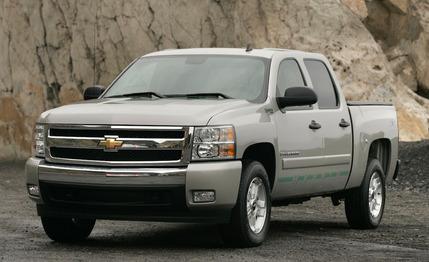 First Drive Review
First Drive Review
What’s an environmentally sensitive ranch hand to do? He loves being out on the range, working with deer, antelope, and Jake Gyllenhaal, but he’s worried that his big, V-8–powered pickup’s odious fuel economy is giving him a Nebraska-sized carbon footprint. If he could just get, say, 25-percent-better fuel economy, he’d sleep a lot more secure in the saddle, and his fuzzy friends would surely appreciate it, too. It’s nice for him, then, that GM is preparing to launch mechanically identical two-mode-hybrid versions of its excellent full-size trucks, the Chevrolet Silverado and the GMC Sierra, and the company claims—hey!—a 25-percent mileage improvement over a comparable gas-only model.
Just Like a Regular Truck—Sort Of
The hybrid system combines GM’s 6.0-liter Vortec V-8 (with a few major changes, including new pistons and revised cam phasing to allow for later-opening intake valves), two electric motors, and a 300-volt battery pack—all working through a sophisticated two-mode transmission that allows the engine to operate at peak efficiency all the time. The tranny essentially combines continuous variability with a four-speed automatic; the infinite gear ratios are efficient for most driving, with the exception of steady-state (think freeway) operation, where internal friction makes locking into one of the four fixed ratios a better option. It’s the same setup found in the Chevrolet Tahoe, GMC Yukon, and Cadillac Escalade hybrids.
After an afternoon’s worth of driving, we can report that these hybrid pickups—available only in crew-cab form and scheduled to go on sale, GM says, “during the first half of 2009”—perform similarly to their fine-driving conventional brethren, with a few differences. First, there is the CVT-induced drone during full-throttle acceleration, where the transmission keeps revs at a high, constant speed, as well as a soft whirring from the electrical components when taking off from a stop. And as with all hybrids, the steering is now electrically boosted and the brakes are of the regenerative type, a setup that offers less pedal travel and a mushy, spongy feel. These traits are definitely noticeable, but were you to buy one of these trucks, we think you’d get used to them rather quickly.
The hybrid's capabilities are down over those of a 6.0-liter-equipped gasoline truck, but it will still do a great deal of what you need done. Towing capacities are 6100 and 5900 pounds for rear- and four-wheel-drive hybrids, respectively, down from 8700 and 8500. Payload capacities drop by a couple hundred pounds as well, to roughly 1450 pounds.
Hydraulic body mounts were developed specifically to cope with the weight of the battery pack—stored under the second-row seat—and are meant to improve the ride over washboard bumps and mitigate frame flex on wavy surfaces; they’ll also carry over to the regular truck. They work well, and although we didn’t have much of a problem with the regular Silverado’s ride, they’re a welcome improvement.